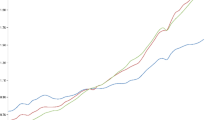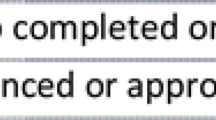Abstract
For more than half a century, research and practice in international development has focused on improving the quality of life of people living in developing regions of the world. Recently, researchers, practitioners, and policy makers have recognized the need to blend insights from experts and community stakeholders in development decisions. Research in the decision sciences tells us that these kinds of multiparty and multiattribute decisions are extremely challenging. However, recent experience using structured decision-making (SDM) approaches suggests that the quality of both expert and stakeholder input, and resulting decisions, can be improved by ensuring that people address a series of basic principles relating to identifying objectives and their associated attributes, estimating the consequences of proposed actions, and directly confronting trade-offs that arise during the evaluation of management alternatives. In this paper, we provide an overview of SDM and then discuss a research initiative aimed at applying the approach to a pressing international development problem in rural Costa Rica: management of the lucrative but also environmentally destructive pineapple industry. The objectives of this research were twofold: First, we sought to help inform policy decisions by eliciting land management preferences regarding the pineapple industry from people living in communities surrounding plantations. Second, we evaluated the effectiveness of the SDM approach in a developing community context.

Similar content being viewed by others
Notes
During the period, this research was conducted, $1 USD ≈ ₡ 523.
Within-attribute differences, determined using a Tukey’s posttest, are shown in Tables 3 through 5. All posttest results shown are significant by a margin of at most p < 0.05.
References
Adamowicz W, Boxall P, Wilhams M, Louviere J (1998) Stated preference approaches for measuring passive use values: choice experiments and contingent valuation. Am J Agric Econ 80:64–67
Ajzen I (2001) Nature and operation of attitudes. Annu Rev Psychol 52:27–58
Alpizar F, Carlsson F (2003) Policy implications and analysis of the determinants of travel mode choice: an application of choice experiments to metropolitan Costa Rica. Environ Dev Econ 8:603–619
Arvai JL, Gregory R (2003) Testing alternative decision approaches for identifying cleanup priorities at contaminated sites. Environ Sci Technol 37:1469–1476
Arvai J, Post K (2012) Risk management in a developing country context: improving decisions about point-of-use water treatment among the rural poor in Tanzania. Risk Anal 32:67–80
Arvai JL, Gregory R, Ohlson D, Blackwell BA, Gray RW (2006) Letdowns, wake-up calls, and constructed preferences: people’s responses to fuel and wildfire risks. J For 104:173–181
Arvai JL, Gregory R, Zaksek M (2007) Improving wildfire risk management decisions. In: Martin W, Martin I, Raish C (eds) Wildfire and fuels management: human perceptions and management implications. RFF Press, Washington, DC
Baron J (2000) Measuring value tradeoffs: problems and some solutions. In: Weber EU, Baron J, Loomes G (eds) Conflict and tradeoffs in decision making: essays in Honor of Jane Beattie. Cambridge University Press, New York
Baron J, Spranca M (1997) Protected values. Organ Behav Hum Decis Process 70:1–16
Bessette D, Arvai J, Campbell-Arvai V (2014) Decision support framework for developing regional energy strategies. Environ Sci Technol 48:1401–1408
Bond S, Carlson K, Keeney RL (2008) Generating objectives: can decision makers articulate what they want? Manag Sci 54:56–70
Boxall P, Adamowicz W, Williams M, Swait J, Louviere J (1996) Comparison of stated preference approaches to the measurement of environmental values. Ecol Econ 18:243–253
Carson RT, Louviere JJ, Anderson DA, Arabie P, Bunch DS, Hensher DA, Johnson RM, Kuhfeld WF, Steinberg D, Swait J, Timmermans H, Wiley JB (1994) Experimental analysis of choice. Mark Lett 5:351–367
Chambers R (1994) The origins and practice of participatory rural appraisal. World Dev 22:953–969
Clemen RT (2004) Making hard decisions: an introduction to decision analysis. PWS-Kent Publishing Co., Boston
Failing L, Gregory R, Harstone M (2007) Integrating science and local knowledge in environmental risk management: a decision-focused approach. Ecol Econ 64:47–60
Gilovich T, Griffin D, Kahneman D (2002) Heuristics and biases: the psychology of intuitive judgment. Cambridge University Press, Cambridge
Gregory R (2003) Incorporating value tradeoffs into community-based environmental risk decisions. Environ Values 11:461–488
Gregory R, Failing L (2002) Using decision analysis to encourage sound deliberation: water use planning in British Columbia, Canada. J Policy Anal Manag 21:492–499
Gregory R, Arvai JL, McDaniels T (2001a) Value-focused thinking for environmental risk consultations. Res Soc Probl Public Policy 9:249–275
Gregory R, McDaniels T, Fields D (2001b) Decision aiding, not dispute resolution: creating insights through structured environmental decisions. J Policy Anal Manag 20:415–432
Gregory R, Failing L, Harstone M, Long G, McDaniels T, Ohlson D (2012) Structured decision making: a practical guide to environmental management choices. Wiley-Blackwell, Chichester
Gregory R, Arvai J, Gerber L (2013) Structuring decisions for managing threatened and endangered species in a changing climate. Conserv Biol 27:1212–1221
Hammond J, Keeney RL, Raiffa H (1999) Smart choices: a practical guide to making better decisions. Harvard Business School Press, Cambridge
Kahneman D (2011) Thinking, fast and slow. Farrar, Straus and Giroux, New York
Kahneman D, Slovic P, Tversky A (1982) Judgment under uncertainty: heuristics and biases. Cambridge University Press, Cambridge
Keeney RL (1992) Value-focused thinking. A path to creative decision making. Harvard University Press, Cambridge
Kellon DS, Arvai J (2011) Five propositions for improving decision making about the environment in developing communities: insights from the decision sciences. J Environ Manag 92:363–371
Kenney L, Vardhan M, Arvai J, Catacutan D (2014). Decision aiding for international multi-party carbon management programs: REDD and REDD+ in Vietnam. Soc Nat Resour (in press)
Kirkwood CW (1997) Strategic decision making: multiobjective analysis with spreadsheets. Duxbury Press, Belmont
Lichtenstein S, Slovic P (2006) The construction of preference. Cambridge University Press, Cambridge
Lichtenstein S, Gregory R, Irwin J (2007) What’s bad is easy: taboo values, affect, and cognition. Judgm Decis Making 2:169–188
Louviere JJ (1988) Analysing decision making: metric conjoint analysis. Sage University Papers Series in Quantitative Applications in the Social Sciences. Sage Publications, Newbury Park, CA
Millennium Ecosystem Assessment (2005) Ecosystems and human well-being: synthesis. Island Press, Washington, DC
Mitchell R, Carson R (1995) Current issues in the design, administration, and analysis of contingent valuation surveys. In: Johansson P, Kristrom B, Maler K (eds) Current issues in environmental economics. Manchester University Press, New York
National Research Council (1996) Understanding risk: informing decisions in a democratic society. National Academy Press, Washington, DC
National Research Council (2007) Strengthening science-based decision making in developing countries. Agriculture and water management. National Academy Press, Washington, DC
Ostrom E (1996) Crossing the great divide: coproduction, synergy, and development. World Dev 24:1073–1087
Payne JW, Bettman JR, Johnson EJ (1992) Behavioral decision research: a constructive processing perspective. Annu Rev Psychol 43:87–132
Richardson RB, Kellon D, León R, Arvai J (2013) Using choice experiments to understand household tradeoffs regarding pineapple production and environmental management in Costa Rica. J Environ Manag 127:308–316
Simon HA (1955) A behavioral model of rational choice. Q J Econ 69:99–118
Slovic P (1995) The construction of preference. Am Psychol 50:364–371
Tetlock PE (2000) Coping with trade-offs: Psychological constraints and political implications. In: Lupia A, Popkin SL, McCubbins MD (eds) Elements of reason: cognition, choice, and the bounds of rationality. Cambridge University Press, Cambridge
Tetlock PE, Kristel OV, Elson SB, Green MC, Lerner JS (2000) The psychology of the unthinkable: taboo tradeoffs, forbidden base rates, and heretical counterfactuals. J Pers Soc Psychol 78:853–870
Tversky A, Kahneman D (1974) Judgment under uncertainty: heuristics and biases. Science 185:1124–1131
von Winterfeldt D, Edwards W (1986) Decision analysis and behavioral research. Cambridge University Press, Cambridge
Wilson RS, Arvai JL (2006) When less is more: how affect influences preferences when comparing low and high-risk options. J Risk Res 9:165–178
Wilson RS, Arvai JL (2010) Why less is more: exploring affect-based value neglect. J Risk Res 13:399–409
Acknowledgments
We are grateful to Carmen Daly, Graham Long, Daniel Sherrard, José Zaglul, and our many colleagues at EARTH University, Costa Rica, for their assistance and insights. This research was supported by The National Science Foundation under award number SES-0924210. Delanie Kellon was supported by a fellowship from the EARTH University Foundation. Any opinions, findings, and conclusions or recommendations expressed in this publication are those of the authors and do not necessarily reflect the views of our research sponsors.
Author information
Authors and Affiliations
Corresponding author
Rights and permissions
About this article
Cite this article
Árvai, J., Kellon, D., León, R. et al. Structuring international development decisions: confronting trade-offs between land use and community development in Costa Rica. Environ Syst Decis 34, 224–236 (2014). https://doi.org/10.1007/s10669-014-9495-4
Published:
Issue Date:
DOI: https://doi.org/10.1007/s10669-014-9495-4




